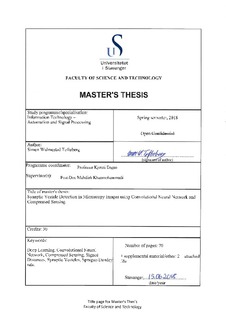| dc.contributor.advisor | Khanmohammadi, Mahdieh | |
| dc.contributor.advisor | Engan, Kjersti | |
| dc.contributor.author | Tofteberg, Simen Walmestad | |
| dc.date.accessioned | 2018-09-27T12:10:44Z | |
| dc.date.available | 2018-09-27T12:10:44Z | |
| dc.date.issued | 2018-06-15 | |
| dc.identifier.uri | http://hdl.handle.net/11250/2565004 | |
| dc.description | Master's thesis in Automation and Signal Processing. | nb_NO |
| dc.description.abstract | In response to stressful situations, the body activates its sympathetic nervous system with the sudden release of hormones. This increases the presence of adrenaline and noradrenaline which improves muscle strength and endurance. The response is the ”fight-or-flight” reflex that prepares the body to endure emergency situations. The effect is recognizable in increased blood pressure, heart rate and breathing. In everyday life, stress can be triggered by deadlines at work or experienced by a student about to deliver their thesis. A small amount of stress can be helpful to motivate and endure difficult situations. However, being exposed to stress over an extended period of time can lead to depression and may increase risk of early development of dementia such as Alzheimer’s disease.
It is hypothesized that being constantly stressed for a prolonged time can affect the signalling between the neurons of the brain. The signalling is a chemical process that uses chemical neurotransmitters stored inside spherical synaptic vesicles. The signal transportation within synapses involves the physical movement of the vesicles towards the pre-synaptic membrane called the active zone. It has been shown that stress influences the distribution of synaptic vesicles.
The objective of this thesis was to develop an automatic synaptic vesicle detection algorithm for use on microscopy images of rat brains. The proposed system is based on a concept of using a Convolutional Neural Network and Compressed Sensing (CNNCS) to predict the synaptic vesicle centers. The neural network is trained to approximate compressed signed distance arrays from different observation axes uniformly distributed around the input image. The approximated compressed signal can be decoded and reconstructed into predicted synaptic vesicle positions in the original image. Based on the experiments and results, the framework of the system has proven to be robust. However, the different neural networks that has been evaluated has not been able to predict these encoded signals significantly accurate due to lack of diversity in the dataset. The best neural network has a mean squared error of 1.61 x10^-2 which needs to be reduced to 1 x10^-4 in order for the system to be able to predict accurate synaptic vesicle positions. | nb_NO |
| dc.language.iso | eng | nb_NO |
| dc.publisher | University of Stavanger, Norway | nb_NO |
| dc.relation.ispartofseries | Masteroppgave/UIS-TN-IDE/2018; | |
| dc.rights | Navngivelse 4.0 Internasjonal | * |
| dc.rights.uri | http://creativecommons.org/licenses/by/4.0/deed.no | * |
| dc.subject | informasjonsteknologi | nb_NO |
| dc.subject | kybernetikk | nb_NO |
| dc.subject | signalbehandling | nb_NO |
| dc.subject | dype nevrale nett | nb_NO |
| dc.subject | compressed sensing | nb_NO |
| dc.subject | synaptisk vesikkel | nb_NO |
| dc.subject | automatisering | nb_NO |
| dc.subject | nevrale nettverk | nb_NO |
| dc.title | Synaptic Vesicle Detection in Microscopy Images using Convolutional Neural Network and Compressed Sensing | nb_NO |
| dc.type | Master thesis | nb_NO |
| dc.subject.nsi | VDP::Teknologi: 500::Informasjons- og kommunikasjonsteknologi: 550 | nb_NO |

